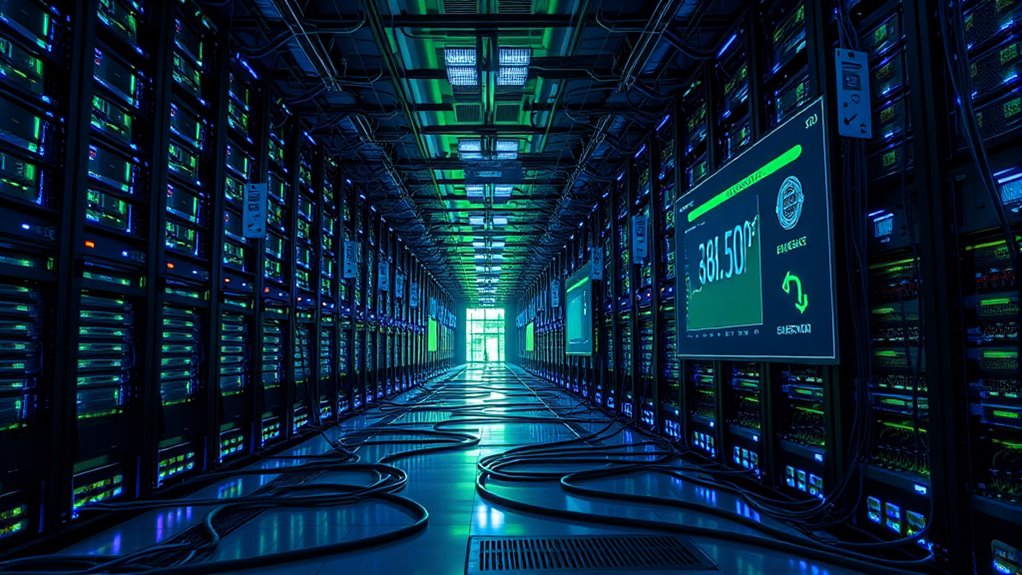As you explore the green GPU race, it’s key to understand that AI training consumes significant energy, often from carbon-heavy sources, increasing its environmental footprint. Efforts focus on designing more efficient hardware, optimizing architectures, and using renewable energy to reduce emissions. While faster GPUs can boost performance, they may also raise carbon costs. To truly grasp the balance between AI progress and sustainability, you’ll discover how industry and innovation are working together to measure and mitigate these impacts.
Key Takeaways
- AI training demands high GPU power, significantly increasing energy consumption and carbon emissions.
- Measuring the carbon cost involves analyzing GPU energy use, training duration, and energy sources like renewables.
- Industry efforts focus on optimizing hardware efficiency and utilizing renewable energy to reduce environmental impact.
- Paradoxes exist where more powerful GPUs can lead to higher emissions despite efficiency improvements.
- Sustainable AI development requires balancing performance advancements with energy-efficient practices and renewable energy adoption.

As gamers and tech enthusiasts increasingly demand high-performance graphics, the environmental impact of GPUs has come into focus. These powerful chips are essential for rendering stunning visuals and training advanced AI models, but their energy consumption and carbon footprint are raising concerns. To address this, the industry is exploring ways to improve hardware efficiency and leverage renewable energy sources. By making GPUs more energy-efficient, manufacturers can reduce the amount of power needed for intense tasks, which directly cuts down carbon emissions. This shift isn’t just about meeting environmental standards; it’s also about ensuring sustainable growth in a tech landscape that’s rapidly expanding.
Using renewable energy is a key part of this effort. Data centers and AI training facilities are increasingly powered by wind, solar, and other clean energy sources. This transformation helps offset the carbon costs associated with GPU operations, making AI training less harmful to the environment. Companies investing in renewable energy not only lower their carbon footprint but also demonstrate a commitment to sustainable innovation. The combination of hardware efficiency and clean energy adoption can considerably reduce the overall environmental impact of GPU-intensive tasks, like gaming and AI model training.
Renewable energy powers data centers and AI labs, reducing the environmental impact of GPU-intensive tasks like gaming and AI training.
However, improving hardware efficiency isn’t straightforward. It requires designing GPUs that deliver high performance without demanding excessive power. Engineers are focused on optimizing architectures, reducing unnecessary energy waste, and developing smarter cooling solutions. These advancements mean that more work can be done with less energy, making high-performance computing more sustainable. For example, newer GPUs are built with better manufacturing processes that minimize power leakage and improve thermal management, allowing for shorter training times and less energy consumption overall.
While the push for greener GPUs is gaining momentum, challenges remain. The demand for higher performance often drives up energy use, creating a paradox where more powerful hardware may consume disproportionately more energy. That’s why ongoing research into hardware efficiency and renewable energy integration is critical. It’s not enough to simply upgrade to faster GPUs; you need to make certain that these upgrades align with sustainable practices. For you, as someone who benefits from these technologies, this means supporting companies that prioritize energy efficiency and renewable power sources, knowing that your gaming and AI pursuits can be both cutting-edge and environmentally responsible.
Furthermore, fostering a culture of creative practice within the industry encourages continuous innovation for more sustainable solutions. Ultimately, balancing high performance with sustainability requires continuous innovation. By focusing on hardware efficiency and tapping into renewable energy, the industry can reduce the carbon costs of GPUs, making AI training and gaming more eco-friendly. This approach not only benefits the planet but also ensures that technological progress remains sustainable in the long run.
Frequently Asked Questions
How Can Consumers Reduce the Carbon Footprint of AI Tools?
To reduce the carbon footprint of AI tools, you can choose services powered by renewable energy, which cuts down on emissions. Additionally, support and participate in carbon offsetting programs to balance out your AI usage’s impact. You might also limit unnecessary AI use and advocate for greener tech practices. These actions help you lower your overall environmental footprint while enjoying the benefits of AI technology.
What Are the Most Energy-Efficient GPU Models Available Today?
Oh, you thought finding energy-efficient GPUs was a walk in the park? Think again! Today, models like NVIDIA’s A100 and AMD’s MI250X lead the charge with sustainable hardware and energy-efficient architectures. They deliver impressive power while sipping energy, helping you cut your carbon footprint. So, if you’re serious about eco-friendly AI, these GPUs are your best bets—because saving the planet shouldn’t mean sacrificing performance.
How Does AI Training Energy Use Compare to Traditional Computing Tasks?
You might wonder how AI training’s energy use stacks up against traditional computing tasks. In a carbon footprint comparison, AI training generally consumes substantially more energy due to complex computations and large datasets. An energy consumption analysis shows that training large models requires vast power, often surpassing routine tasks like word processing or browsing. This highlights the importance of optimizing AI efficiency to reduce environmental impact.
Are There Policies Incentivizing Greener AI Hardware Development?
Imagine it’s 2050, and green tech is everywhere. Currently, policymakers are pushing for policy incentives that promote greener AI hardware development, aiming to reduce energy consumption and carbon footprints. These incentives encourage companies to prioritize eco-friendly materials and energy-efficient designs, aligning innovation with sustainability goals. Such policies help accelerate the shift toward environmentally responsible AI, making greener tech not just a goal but a standard in sustainable development.
What Future Innovations Could Lower AI Training’S Environmental Impact?
To lower AI training’s environmental impact, you can look forward to innovations like increased use of renewable energy sources, which reduce carbon emissions during training. Additionally, advancements in hardware recycling will extend device lifespans and minimize e-waste. These innovations, combined with more energy-efficient algorithms, will make AI development greener, helping you reduce its carbon footprint and support sustainable tech progress.
Conclusion
So, as you dive deeper into AI, it’s no coincidence that the green GPU race is more than just tech jargon—it’s about your impact. Every choice you make, from hardware to energy sources, shapes the planet’s future. Remember, the real carbon cost isn’t just in the hardware but in how you use it. By staying informed and eco-conscious, you can turn the tide and make a difference—just like the green GPUs are trying to do.









